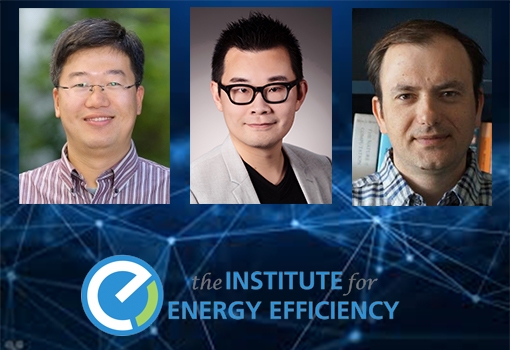Training artificial intelligence (AI), an activity that involves processing vast amounts of data, is an energy-intensive process. One recent estimate by a researcher at the University of Massachusetts Amherst suggested that training a single AI creates a carbon dioxide (CO2) footprint of 626,000 pounds, or five times the lifetime emissions of the average American car. That same paper asserted that using a state-of-the-art language model for natural language processing equals the CO2 emissions of one human for 30 years. Both findings provide a jarring quantification of AI’s environmental impact, which becomes more troublesome since nearly every industry uses AI and machining learning (ML) to improve decision making and problem solving.
Two innovative projects, each awarded $50,000 in seed funding this month by UC Santa Barbara’s Institute for Energy Efficiency (IEE), are designed to make AI and machine learning more efficient.
Professor Xifeng Yan and assistant professor William Wang, both faculty in the Computer Science Department, are teaming up to improve the energy efficiency of AI and machine learning at the algorithmic and systems levels. Their work could potentially impact industry and academia.
Dmitri Strukov, an electrical and computer engineering professor, plans to attack the challenge by advancing computer architecture and hardware. He proposes using technology, designed similar to the human brain, for solving some of the hardest optimization problems. His project, Energy-Efficient Mixed-Signal Neuro-Optimization Hardware, employs mixed-signal neuromorphic circuits with integrated metal-oxide memristors, which are non-volatile memory devices that his group has been developing for the past ten years. Such circuits enable very dense, fast, and energy-efficient implementation of probabilistic vector-by-matrix multiplier, which is the most common operation in bio-inspired optimization algorithms. The preliminary results from his group show that the proposed hardware implementation is estimated to be 70 times faster and 20,000 times more energy efficient compared to the most efficient conventional approach.
With the seed funding, Strukov plans to redesign existing circuits and build an interdisciplinary team of people who specialize in algorithms, application domain, and system integration.
The two projects were among the four awarded inaugural seed funding grants this month by the IEE. The awards were made possible through a gift from an anonymous donor. The selected projects are in the early stages of development and align with at least one of IEE’s three central themes: computing and communications, smart societal infrastructure, and the food-energy-water nexus. The seed funding is intended to produce preliminary results that UCSB scientists can use to apply for major external funding to further fund and expand their research.
The IEE also awarded seed funding to projects that could drastically help the citrus industry, and create a new energy storage solution for the electric grid.
New proposals for funding will be accepted starting July 1, 2020.

UCSB professors Xifeng Yan (left), William Wang (center), and Dmitri Strukov (right) proposed projects selected for seed funding by the IEE.
